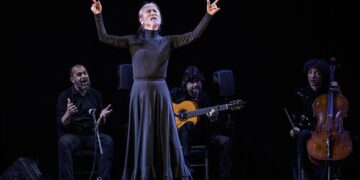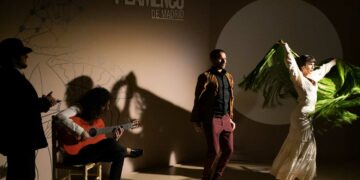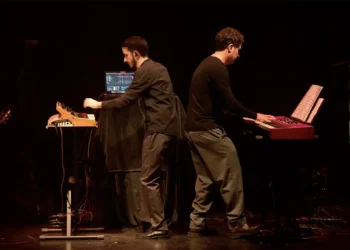|
XV FESTIVAL DE JEREZ |
|
Text: Estela Zatania The third day of the Festival de Jerez investigator Paco Vargas presented his new book “El Flamenco en Málaga”. And in the evening, two very different shows confirmed the organization’s intention of presenting a varied program to suit all tastes BALLET SHOJI KOJIMA FLAMENCO “LA CELESTINA” Dance: Shoji Kojima, Cristián Lozano, Esmeralda Manzanas Sánchez, Ángel Sánchez Fariña, Pablo Fraile, Ayumi Yanagiya, Kanako Maeda, Konomi Tsumori, Hugo López, Harumitsu Seki, Tomoya Matsuda, Chiharu Okano, Yumiko Kojima, Junko Takeuchi, Etsuko Kiuchi, Moegi Hata, Junko Sujino, Francisco Morgado, Tomoya Matsuda, Satoyo Kamata, Haruna Kubota, Yoko Saito, Tamaki Kinoshita, Ayako Obayashi, Yayoi Seki, Moegi Hata, Junko Sujino, Satoyo Kamata, Haruna Kubota, Yoko Saito, Tamaki Kinoshita. Cante: El Londro, Jesús Méndez, Mónica Navarro. Guitar: Chicuelo, Salva de María. Violin: Olvido Lanza. Cello: Lito Iglesias. Percussion: Pedro Manuel Navarro Grimaldi. Director and choreographer: Javier Latorre. Music director: Chicuelo. Shoji Kojima’s nickname “Japanese Gypsy”, could easily be a reference to his chiselled features, reminiscent of a Pelao or an Agujeta family member. As a young man he came to Spain about 45 years ago to cultivate his already incurable interest in flamenco, and last night he brought his large dance company to the Villamarta theater. It’s not the first time a mainly Japanese group has performed at the venerable theater, but the first time in the history of this festival, which is the biggest international event of its kind. The ambitious show is a representation of the classic work “La Celestina”, a complicated story of love, treachery and death from the sixteenth century. Kojima himself, at seventy-something, plays the main role, and his androgynous interpretation was worthy of one of the statuettes that was being handed out in Hollywood at almost the same hour. In fact, his dramatic capacity goes beyond his dancing, a circumstance that was no impediment because most of his role was gesticulation and pantomime. There have been other danced versions of La Celestina, a tangled story not easily followed even if you’re familiar with the plot. An overly busy production further complicated the performance, and a cast of some forty individuals, not counting the technical team, proved without a doubt the wisdom of “less is more”. Guitarist Chicuelo, also credited as music director, was noteworthy despite having had to bear a personal tragedy only hours before show-time. Singers Londro, Jesús Méndez and Mónica Navarro gave the flamenco touch, although the use of harmonized singing was way overdone, lightening the natural tension of the cante. “La Celestina” is much closer to Spanish dance than flamenco, but a guajira, and a farruca duet were highpoints.
Last year, young Cádiz dancer Jesús Fernández won the Desplante, highest dance prize of the Festival del Cante de las Minas de La Unión, and with this new work called “Ataduras”, he has taken another big step forward in his career. Impressive tangos with cantes from Cádiz, Málaga and Granada with an original flavor, and malagueñas by the singers rounded off with abandolao show the high level of David el Galli and Miguel Rosendo. The caña, a form urgently in need of reworking, really came to life thanks to Jesús, the two singers, and guitarists Antonia Jiménez and Jesús Guerrero. Soleá and bulerías, and the palmas of Sonia Poveda and Lidia Valle complete a well-conceived show that depends not on lavish financing, but raw talent, knowledge and lots of hard work. |





 JESÚS FERNÁNDEZ “ATADURAS”
JESÚS FERNÁNDEZ “ATADURAS”



















